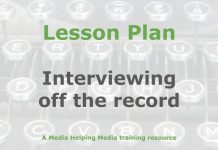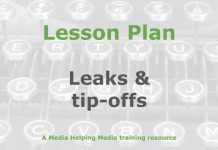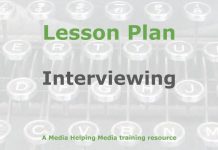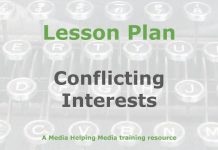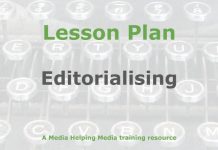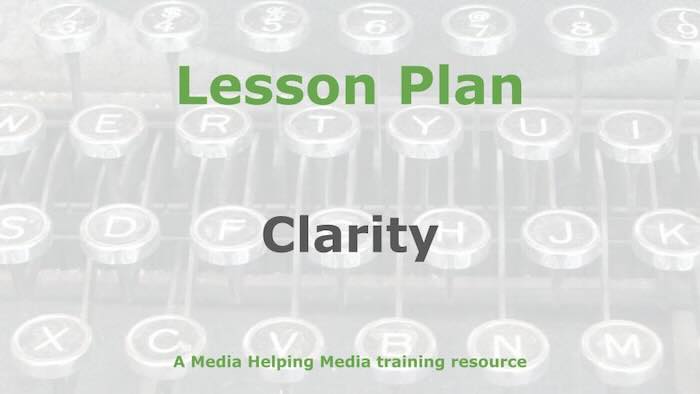 This lesson plan is designed to help students understand the importance of clarity in their writing so that they produce news articles that the reader can understand
This lesson plan is designed to help students understand the importance of clarity in their writing so that they produce news articles that the reader can understand
We recommend trainers read the article ‘Clarity is as important as accuracy‘ which is published on Media Helping Media before adapting the lesson plan for their own purposes.
Learning objective
Students will evaluate the clarity of journalistic writing by identifying and revising unclear language. They will apply principles of clear writing to ensure both accuracy and reader comprehension in news articles.
- Student-facing objective: By the end of this lesson the student will be able to spot unclear language in news articles and make their writing clearer while maintaining accuracy.
- Standards: Journalism students will learn that clarity is as important as accuracy.
Learning activities
Warm-up
Present students with two short news excerpts. One is clear and concise, the other is verbose and unclear. Ask students to read both silently and then discuss with a partner which excerpt they found easier to understand and why. Encourage them to focus on specific language choices that contributed to clarity or confusion. After a few minutes, facilitate a brief class discussion to highlight their observations. This primes students to think critically about clarity in journalism.
Direct instruction
Introduce clarity principles: Begin by explaining the importance of clarity in journalism. Discuss how clarity ensures reader comprehension and maintains accuracy. Highlight Orwell’s six rules for clear writing, emphasising the avoidance of clichés, jargon, and unnecessary words. Use real-world examples to illustrate these points, such as comparing a clear news headline with a convoluted one.
Analyse examples: Present students with a news article containing unclear language. As a class, identify specific instances where clarity is lacking. Discuss why these choices hinder understanding and how they could be improved. Encourage students to suggest revisions, focusing on simplifying language and restructuring sentences for clarity.
Revise for clarity: Provide students with a short, unclear news excerpt. Instruct them to rewrite the excerpt, applying the principles discussed. Emphasise the use of active voice, short words, and straightforward language. Afterward, select a few students to share their revisions with the class, discussing the changes made and their impact on clarity.
Guided practice
Conduct a Think, Pair, Share activity to reinforce clarity principles:
- Think: Present students with a short, unclear news excerpt. Ask them to individually identify unclear language and note potential revisions for clarity.
- Pair: Have students pair up to discuss their findings and proposed revisions. Encourage them to explain their reasoning and consider their partner’s suggestions.
- Share: Facilitate a class discussion where pairs share their insights and revisions. Highlight effective strategies for improving clarity. Use this opportunity to address any misconceptions.
- Class feedback: Provide feedback on the shared revisions, emphasising the application of clarity principles. Encourage students to reflect on how these principles enhance reader comprehension.
- Revisit principles: Conclude by revisiting Orwell’s six rules and other clarity principles. Reinforce their importance in journalistic writing.
Independent practice
- Provide students with a news article containing unclear language. Ask them to identify and revise unclear sections, applying clarity principles.
- Direct students to a related exercise for additional practice.
- Circulate to observe and support students as needed.
Assignment
Ask students to answer these questions:
- What is one principle of clarity in journalism that you applied today?
- How does clarity in writing affect reader comprehension?
- What’s one question you still have from today’s lesson?
Here are some suggested answers:
Suggested answer to Question 1: Avoiding jargon and using straightforward language.
Suggested answer to Question 2: Clarity ensures that readers can easily understand the information being presented, which maintains accuracy and engagement.
Teacher resources
Differentiation guide
- Advanced learners: Encourage them to explore complex articles with technical jargon. Challenge them to translate these into clear, accessible language while maintaining accuracy. Suggest they analyse the impact of clarity on reader engagement and comprehension in different contexts.
- Striving learners: Provide additional examples of unclear language and clear revisions. Use guided questions to help them identify unclear elements. Offer sentence starters or templates to support their revisions. Pair them with peers for collaborative practice to build confidence.
- Background reading: We recommend trainers read the article ‘For journalists, clarity is as important as accuracy‘ before adapting the lesson plan for their own purposes.
Notable definitions
Clarity: The quality of being easily understood, free from ambiguity, and straightforward in expression. In journalism, clarity ensures that the audience comprehends the information accurately and efficiently.
Jargon: Specialised or technical language used by a particular group, often difficult for outsiders to understand. In journalism, avoiding jargon is crucial to maintain clarity and accessibility for a broad audience.
Active voice: A grammatical structure where the subject performs the action expressed by the verb. Using active voice in journalism enhances clarity by making sentences more direct and easier to understand.
Required materials
- News articles with unclear language for analysis and revision
- Copies of Orwell’s six rules for clear writing
- Writing materials (paper, pens)
- Access to computers or tablets for digital editing (optional)
Lesson summary
- Warm-up
- Direct instruction
- Guided practice
- Assignment
The free teaching tools at the Khan Academy were used in the production of this lesson plan.
Related article


